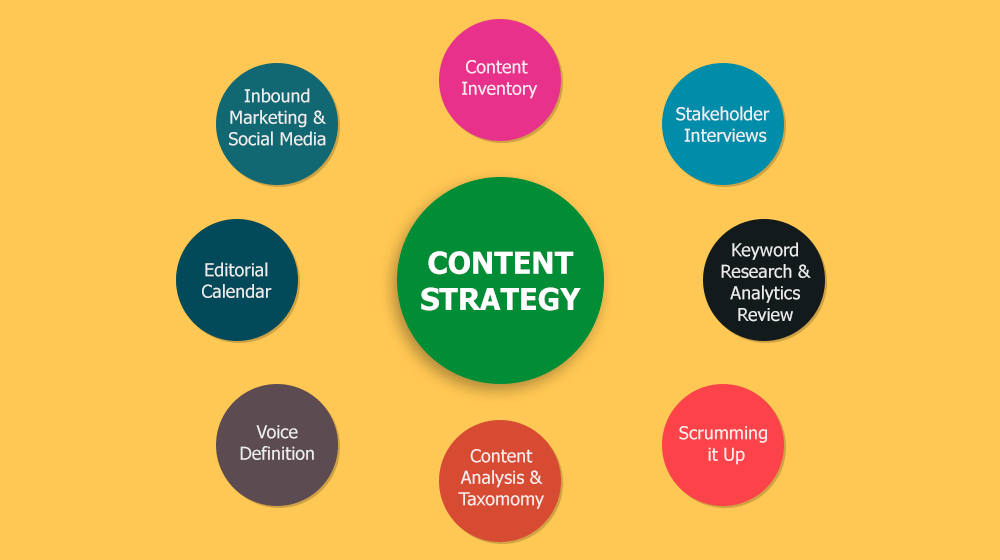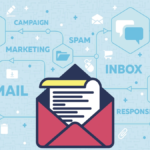It never hurts to review your steps to create a digital content strategy and make sure it’s creative and engaging for your prospects and consumers, regardless of how long you’ve been using the same technique or how new you are to content marketing. A content strategy includes organizing, creating, publishing, overseeing, and controlling content.
An effective content strategy will attract and retain a target audience, meeting their needs and furthering corporate goals. The entice and delight phases of your buyer’s journey, which adhere to the inbound marketing structure, are built upon your content strategy.
Let’s say that raising brand awareness is one of your company’s objectives. In order to accomplish this, you may utilize a content strategy that is centered on search engine optimization (SEO) to improve your website’s visibility on search engine results pages (SERPs) and increase traffic to your goods and services.
A content strategy may be used to attract new clients and boost customer satisfaction and sales. Furthermore, creating a strong content strategy is essential to competing in your business, as 70% of marketers are currently spending on content marketing.
Tips To Create a Digital Content Strategy

1. Know Your Target Audience And Buyer Personas
To really connect with your consumers, you need to first figure out what they are like, what they need, and what they like. This means looking at their demographics, habits, reasons for doing things, and problems they encounter. Once you know what you want, develop thorough buyer personas, which are made-up versions of your ideal customers.
These personas help you understand your audience better, which makes it simpler to customize your tone, content, and message. You can greatly improve relevancy, engagement, and conversion rates by making sure that your content matches what your audience wants and values with the steps to create a digital content strategy.
Content that speaks directly to your audience’s problems or goals is more likely to get their attention and make them want to do something. In the end, creating well-researched buyer personas makes sure that your marketing is focused, tailored to each individual, and more likely to generate trust and long-term connections with customers.
2. Specify Your Objective
Before entering into how to enhance digital content strategy, it’s crucial to explicitly establish what you aim to accomplish with your content marketing approach. Are you seeking to enhance brand exposure, drive website traffic, create leads, or promote consumer engagement and loyalty?
Understanding your motives helps influence the direction and emphasis of your plan. These questions may seem simple, but they form the core of a successful, results-driven content strategy. Start by assessing your organization’s larger business goals, analyzing internal meeting minutes, team conversations, and thoughts from stakeholders.
Then, perform your own independent research to determine trends, consumer expectations, and industry standards. This ensures your objectives are not only connected with your company’s vision but also practical and quantifiable. A defined objective will drive your content development activities, assuring consistency, effectiveness, and long-term sustainability.
3. Prioritize Your Objectives
Once you’ve identified your content marketing goals, the next critical step is to prioritize them based on importance and urgency. Not all objectives have the same weight or demand urgent action, so categorizing them helps you manage time, energy, and resources more efficiently.
Start by evaluating which goals will have the most influence on your entire company strategy or marketing success. This prioritizing will help you concentrate on what is genuinely important, ensuring your efforts create significant outcomes. It also gives clarity to your planning process and helps minimize overburden by creating a defined route.
Additionally, when problems concerning resources—such as funding, people, or tools—arise later, having a sorted list of goals gives a handy reference. This helps you to make wiser judgments and change your plan without losing sight of your most crucial objectives.
4. Conduct A Content Audit And Analysis
Conducting a content audit is one of the vital steps in creating a digital content strategy. By properly examining your existing content, you can discover what is working effectively and what isn’t reaching expectations. Look at key performance indicators (KPIs), including engagement rates, conversion rates, and traffic statistics, to measure content efficacy.
This examination will identify effective elements and places where improvement is required. Moreover, a content audit helps you detect gaps or missing parts in your present content collection, ensuring all important themes and client demands are being handled. Are there places where your audience’s queries remain unanswered or subjects that haven’t been covered yet?
By detecting these flaws, you can realign your content to better suit your company objectives and create a more coherent, valued experience for your audience.
5. Identify Content Types And Formats
When building a content marketing plan, choosing the correct sorts of material is crucial to engaging your audience successfully. Start by examining what sorts of content connect best with your target market. Are they more inclined to interact with blog entries that give in-depth insights, or do they favor fast, visual information like infographics or social media updates?
Videos are another strong medium, particularly for teaching complicated subjects or demonstrating things in action. Determine which formats not only catch attention but also correspond with your audience’s tastes and habits.
For example, younger audiences could be more likely to connect with TikTok videos, while professionals may prefer well-researched white papers or LinkedIn postings. Choosing the ideal content format ensures your ideas are delivered effectively, helping you develop a closer connection with your audience and improving engagement.
6. Create A Distribution Strategy And Content Schedule
Creating a well-structured publishing and marketing strategy is vital for ensuring your material reaches the correct audience at the right time. This requires arranging when and where each piece of content will be published and marketed across numerous platforms, including your website, social media channels, email newsletters, and paid advertising campaigns.
Each channel has its strengths—social media is good for instant interaction, while email marketing delivers more tailored communication. Your strategy should specify how material will be customized for each channel to optimize its effect.
Additionally, if your organization works in different countries or serves varied markets, localization becomes a significant aspect of this approach. This entails modifying material to suit local languages, customs, and interests to ensure it connects with each individual audience. A thorough, multi-channel strategy promotes reach, consistency, and audience connection.
Read More: 8 Digital Marketing Tools To Help You Grow
7. Establish Metrics And KPIs For Measuring Success
To properly answer how to enhance digital content strategy and assess the effectiveness of your content marketing campaign, it’s vital to develop and monitor key performance indicators (KPIs) that fit with your company objectives. Common KPIs include revenue growth, lead creation, website traffic, conversion rates, and engagement measures like time on page, social shares, and comments.
These indicators give significant information about how your content connects with your target audience and whether it inspires meaningful actions. Regularly monitoring these KPIs helps you to measure the efficacy of your digital content strategy in real time.
It also helps you to analyze patterns, recognize failing content, and make data-driven choices to enhance future campaigns. By regularly improving your strategy based on KPI performance, you can guarantee your content marketing activities stay aligned with company goals and contribute to long-term business success.
8. Seek Options For Reuse
Content may be repurposed in several successful ways to enhance reach and engagement. Repurposing helps you to optimize content across numerous channels, saving work while extending your audience. One strong technique is to take your top-performing blog entries, social media updates, or newsletters and turn them into new forms.
For example, you might adapt a popular post into a YouTube video, an informative podcast episode, or even a thorough booklet. This technique not only refreshes current information but also accommodates diverse user preferences—some individuals like viewing videos, while others love reading or listening.
By rethinking content to fit multiple media, you preserve consistency in message and prolong your material’s lifecycle, all while improving exposure and attracting more visitors.
9. Find The Right Tools
Once your content marketing strategy is decided, the next crucial step is picking the most efficient, scalable, and future-proof tools and technology that will help bring your plan to life. These tools should not only coincide with your aims but also be practical for everyday usage, ensuring that your team can execute the plan consistently and efficiently.
One of the most critical tools is a dependable content management system (CMS). A good CMS accelerates the process of developing, organizing, publishing, and optimizing content across numerous media. It also offers collaboration, workflow management, and interaction with other marketing tools such as analytics platforms, SEO tools, and customer relationship management (CRM) systems.
Choosing the proper technological stack provides long-term efficiency, higher team productivity, and the ability to adapt as your content marketing demands grow over time.
Why People Need A Good Content Strategy
In today’s digital world, content is more than simply information—it’s a vehicle for connection, impact, and development. Whether you’re a corporation, influencer, or organization, having a smart content strategy is vital for attaining your objectives and standing out in a competitive environment.
A content strategy helps identify what you want to say, who you’re talking to, and how best to express it. Without one, your message might appear scattered, inconsistent, or irrelevant. A great plan guarantees that every piece of content—whether a blog post, video, or social media update—serves a clear purpose and supports your overall aims.
One of the primary advantages of a successful content strategy is consistency. Audiences desire dependability, and continuously offering great information helps develop confidence and reputation over time. It also enhances SEO (search engine optimization), making it simpler for your target audience to discover you online.
Moreover, the steps to create a digital content strategy help you manage resources more efficiently, eliminate duplication, and monitor effectiveness. You’ll know what’s working, what isn’t, and how to react swiftly.
In a fast-paced digital age, material without direction is quickly forgotten. A smart content strategy keeps you focused, guarantees alignment with your brand, and allows long-term success. Whether you’re seeking to educate, amuse, or sell, having a strategy in place provides your content the potential to make an impact.
FAQ
Q: In digital marketing, what is an FAQ?
A: FAQ stands for frequently asked questions. An FAQ is a section that provides clear answers to common questions customers might have about a product, service, or topic. It helps improve user experience, build trust, and can also boost SEO by targeting relevant search queries.
Q: What is the number of different kinds of digital content?
A: More precisely, digital content comprises text (such as emails, data sets, and blog posts), audio (such as music and podcasts), visuals (such as digital images, videos, and animations), and software (such as computer programs and mobile applications).
Q: Which four goals does digital content serve?
A: The matrix depicts the four primary goals of content and was inspired by Smart Insights. Depending on where your buyer personas are in the funnel, your content should either inspire, inform, amuse, or persuade.








Your blog is a testament to your passion for your subject matter. Your enthusiasm is infectious, and it’s clear that you put your heart and soul into every post. Keep up the fantastic work!
Thank you so much for such a thoughtful message! Your words mean a lot and truly motivate me to keep creating with even more passion. Grateful for your support!
I enjoy your writing style genuinely loving this website .
I’m really glad to hear that! Your appreciation truly motivates me to keep sharing more valuable content. Thanks for the love and support!